For the last few blog posts, I’ve been relating facts, many of which are true, about my recent cruise to Alaska with my wife, Jean, and traveling companions Brenda and Mike. I’ll resume my account on the morning after we slept aboard our cruise ship, MS Hellandam, moored in Juneau.
I awoke to see the vessel backing into a slip in the town of Skagway. It’s at 59°, 26’N, 135°20’W, where the sun had risen early, at 4:34 am, and wouldn’t set until 9:23 pm. This was as far north as we would ever travel on our cruise.
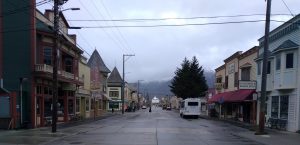
Feeling adventurous, Jean and I bundled up and walked into town, despite the 48°F temperature, gusty winds, and spitting rain. As with Juneau, the town sat at the feet of huge, snow-topped mountains. Once again, we passed many tourist shops, mostly selling jewelry. We walked to the far end of Broadway Street, found the Post Office, and mailed post cards.
Then a strange thing happened.
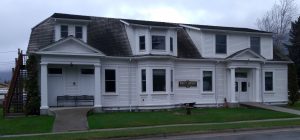
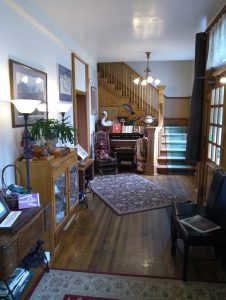
The wind and rain picked up, buffeting us and steering us down a side street. We felt driven toward a lonely hotel, far from the areas where tourists go. Why would someone put an inn here? Did the sign really say ‘No Vacancy?’ We went in to the White House hotel, and found nobody in its small lobby. Turning right, I saw a woman descending the stairs. Attired in an off-white dress with frills and a high collar, she seemed to fit the 1902-era décor. I told her we didn’t want a room; we were just getting warm and dry for a few minutes. She said nothing, but just stared at us. I asked if I could take her picture, and she gave no answer. I took a photo anyway, and she turned and walked upstairs without a word.
Oddly, she does not appear in the photograph. After a moment, a second, and younger, woman came out to the lobby desk and asked if she could help us. I said we’d just spoken to a dark-haired woman in a frilly white dress. The receptionist said no one in the hotel matched that description, but some previous guests had reported seeing a ghost in the inn, a woman dating from a time when the White House hotel was a day care center.
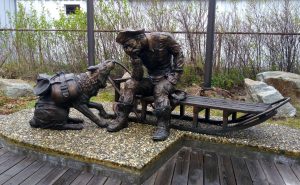
On the way back to our ship, Jean and I bought some gifts and passed by a wonderful statue of a luckless prospector and his ever-faithful dog.
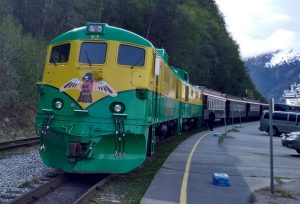
After a buffet lunch on the Lido Deck, the four of us took a ride on the White Pass & Yukon Route Railroad. The green-and-yellow engine bore a picture of a thunderbird, making me shudder to recall the previous day’s encounter. The train cars felt warm inside, and came equipped with large windows and an outer, railed platform at each end. Tour guides kept us informed of sights as we clacked along, climbing from Skagway’s sea level to nearly 3000 feet in 20 miles.
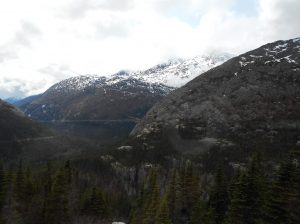
This unique track, constructed for the Yukon Gold Rush starting in 1897, featured bends, bridges, two tunnels, and breathtaking mountain vistas. Over the eons, a fast river surging at the bottom had etched deep gorges between the peaks. Along the way, we saw waterfalls cascading down the mountains that towered to phenomenal heights around us. As we neared the summit, the river’s source proved to be a tiny creek fed by a small, deep, icy lake near the top.
At the summit, the engine detached and moved to our train’s other end. All passengers switched seats around to face the other way and swapped sides so everyone could get both views. After the trip back down, Jean and I returned to the ship and relaxed, while Mike and Brenda explored Skagway.
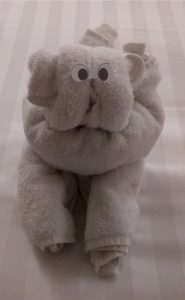
We dressed for a semi-formal meal in the Main Dining Room at 8:00 pm (I had delicious Halibut and Mahi-mahi). Our creative steward had left another towel-sculpture on our bed, this one unidentifiable. The ship got underway at 9:00 pm. We left Skagway in our wake, a town not to be forgotten by—
Poseidon’s Scribe
